Bioscience 1 Assessment 2 (Part B)
VerifiedAdded on 2022/12/30
|7
|1554
|89
AI Summary
This document is about Bioscience 1 Assessment 2 (Part B) which includes feedback review on Part A and short answer questions related to the cardiac conduction system and vitamin B12. It emphasizes the importance of referencing and paraphrasing for academic style and referencing.
Contribute Materials
Your contribution can guide someone’s learning journey. Share your
documents today.
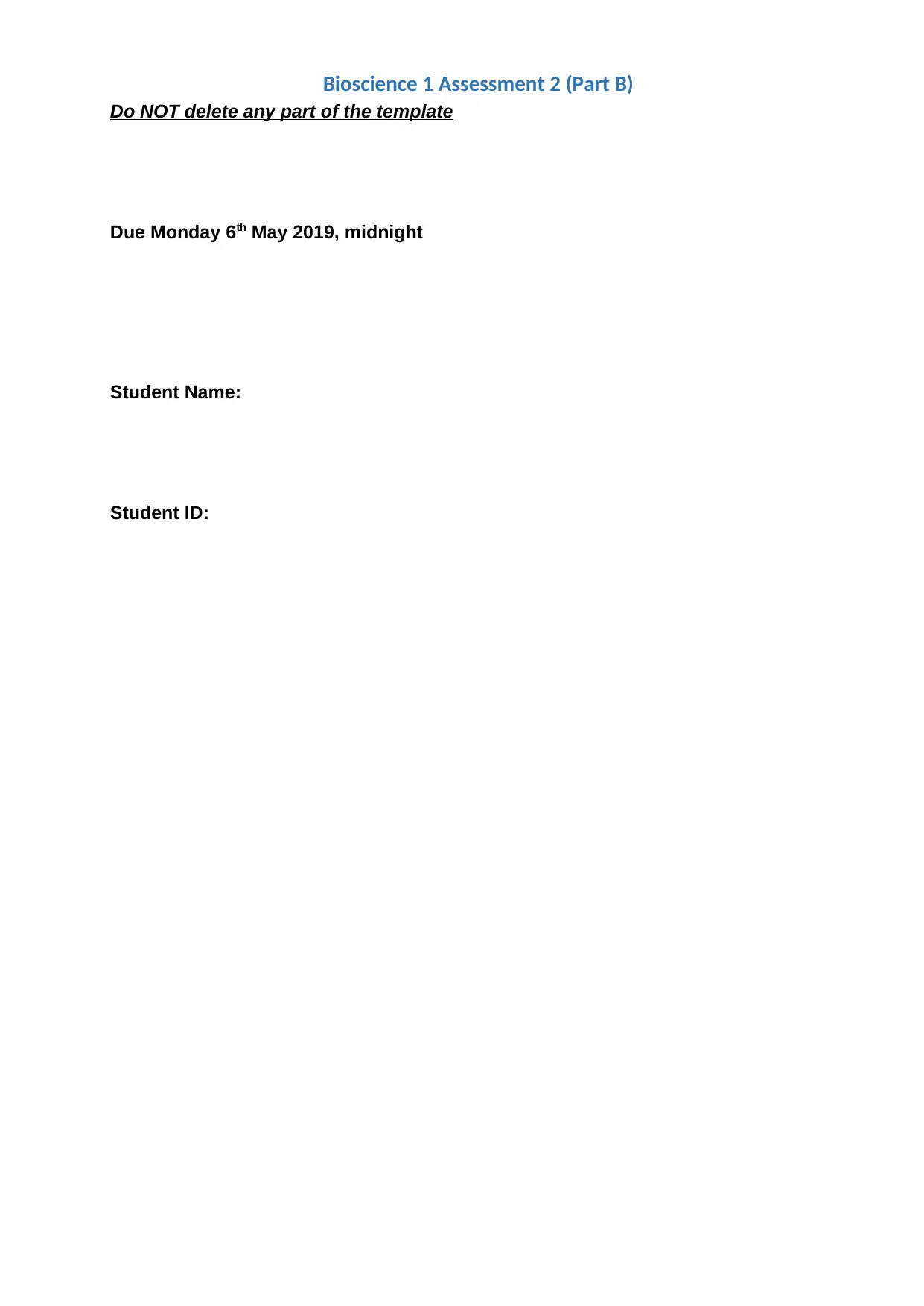
Bioscience 1 Assessment 2 (Part B)
Do NOT delete any part of the template
Due Monday 6th May 2019, midnight
Student Name:
Student ID:
Do NOT delete any part of the template
Due Monday 6th May 2019, midnight
Student Name:
Student ID:
Secure Best Marks with AI Grader
Need help grading? Try our AI Grader for instant feedback on your assignments.
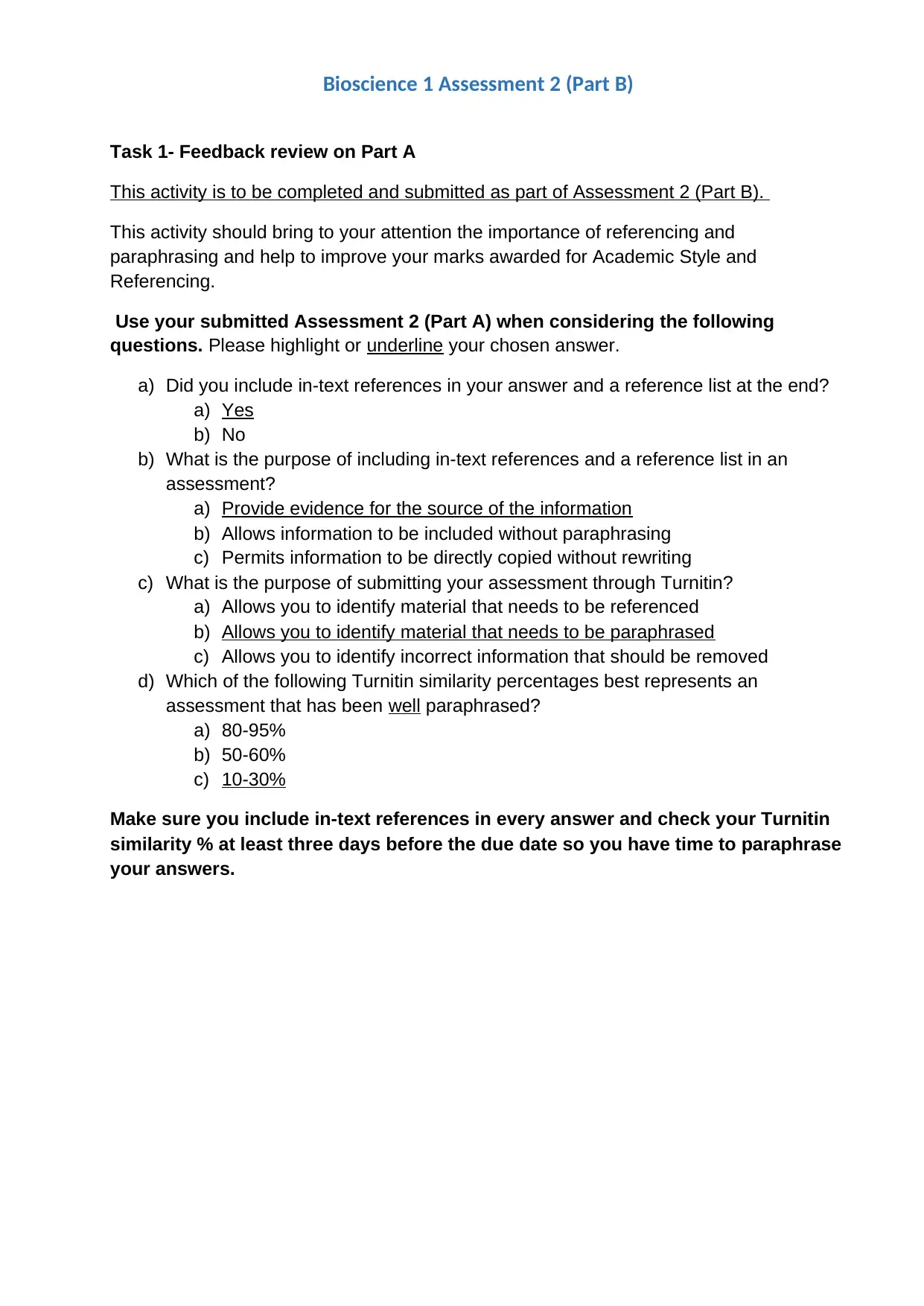
Bioscience 1 Assessment 2 (Part B)
Task 1- Feedback review on Part A
This activity is to be completed and submitted as part of Assessment 2 (Part B).
This activity should bring to your attention the importance of referencing and
paraphrasing and help to improve your marks awarded for Academic Style and
Referencing.
Use your submitted Assessment 2 (Part A) when considering the following
questions. Please highlight or underline your chosen answer.
a) Did you include in-text references in your answer and a reference list at the end?
a) Yes
b) No
b) What is the purpose of including in-text references and a reference list in an
assessment?
a) Provide evidence for the source of the information
b) Allows information to be included without paraphrasing
c) Permits information to be directly copied without rewriting
c) What is the purpose of submitting your assessment through Turnitin?
a) Allows you to identify material that needs to be referenced
b) Allows you to identify material that needs to be paraphrased
c) Allows you to identify incorrect information that should be removed
d) Which of the following Turnitin similarity percentages best represents an
assessment that has been well paraphrased?
a) 80-95%
b) 50-60%
c) 10-30%
Make sure you include in-text references in every answer and check your Turnitin
similarity % at least three days before the due date so you have time to paraphrase
your answers.
Task 1- Feedback review on Part A
This activity is to be completed and submitted as part of Assessment 2 (Part B).
This activity should bring to your attention the importance of referencing and
paraphrasing and help to improve your marks awarded for Academic Style and
Referencing.
Use your submitted Assessment 2 (Part A) when considering the following
questions. Please highlight or underline your chosen answer.
a) Did you include in-text references in your answer and a reference list at the end?
a) Yes
b) No
b) What is the purpose of including in-text references and a reference list in an
assessment?
a) Provide evidence for the source of the information
b) Allows information to be included without paraphrasing
c) Permits information to be directly copied without rewriting
c) What is the purpose of submitting your assessment through Turnitin?
a) Allows you to identify material that needs to be referenced
b) Allows you to identify material that needs to be paraphrased
c) Allows you to identify incorrect information that should be removed
d) Which of the following Turnitin similarity percentages best represents an
assessment that has been well paraphrased?
a) 80-95%
b) 50-60%
c) 10-30%
Make sure you include in-text references in every answer and check your Turnitin
similarity % at least three days before the due date so you have time to paraphrase
your answers.
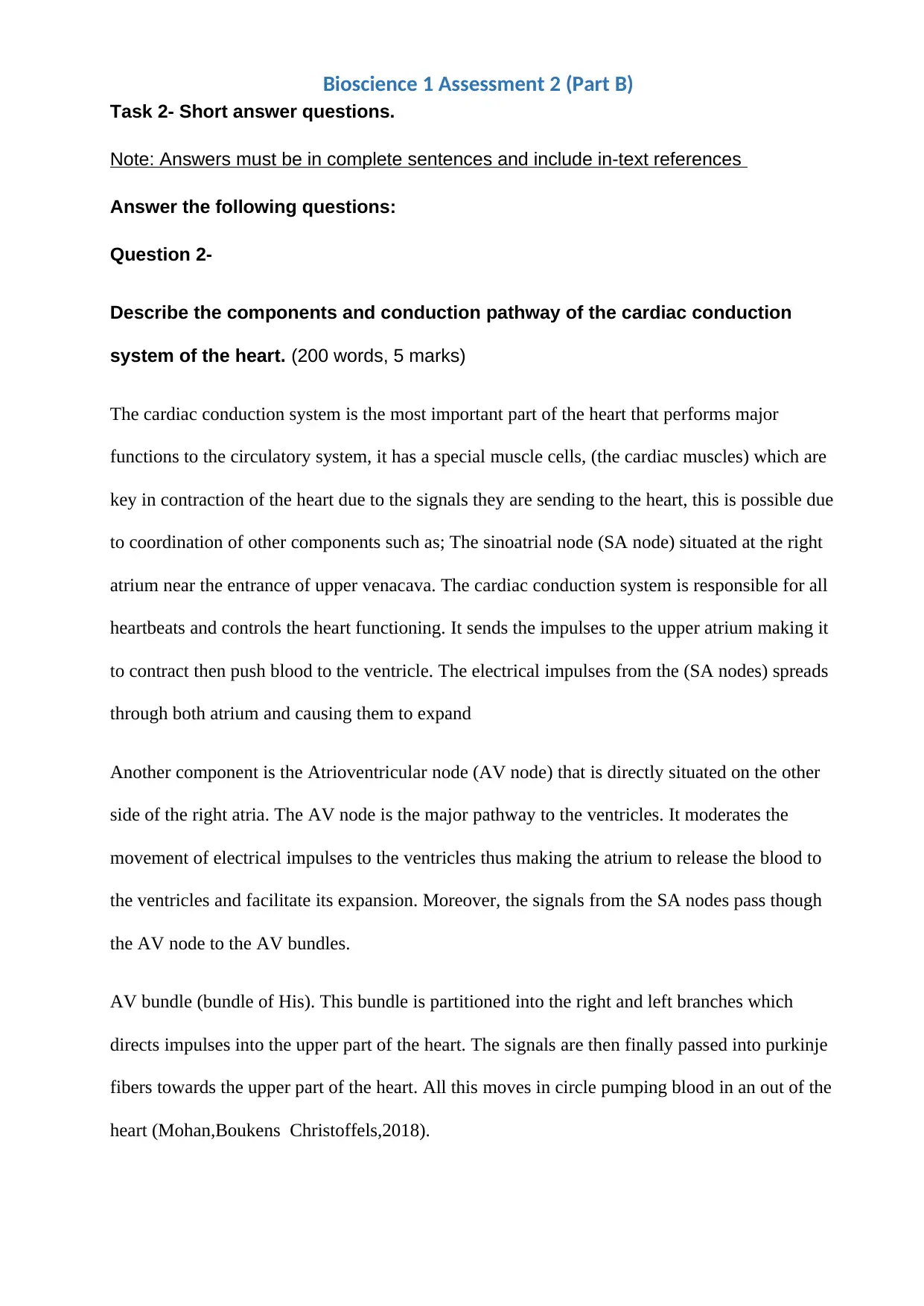
Bioscience 1 Assessment 2 (Part B)
Task 2- Short answer questions.
Note: Answers must be in complete sentences and include in-text references
Answer the following questions:
Question 2-
Describe the components and conduction pathway of the cardiac conduction
system of the heart. (200 words, 5 marks)
The cardiac conduction system is the most important part of the heart that performs major
functions to the circulatory system, it has a special muscle cells, (the cardiac muscles) which are
key in contraction of the heart due to the signals they are sending to the heart, this is possible due
to coordination of other components such as; The sinoatrial node (SA node) situated at the right
atrium near the entrance of upper venacava. The cardiac conduction system is responsible for all
heartbeats and controls the heart functioning. It sends the impulses to the upper atrium making it
to contract then push blood to the ventricle. The electrical impulses from the (SA nodes) spreads
through both atrium and causing them to expand
Another component is the Atrioventricular node (AV node) that is directly situated on the other
side of the right atria. The AV node is the major pathway to the ventricles. It moderates the
movement of electrical impulses to the ventricles thus making the atrium to release the blood to
the ventricles and facilitate its expansion. Moreover, the signals from the SA nodes pass though
the AV node to the AV bundles.
AV bundle (bundle of His). This bundle is partitioned into the right and left branches which
directs impulses into the upper part of the heart. The signals are then finally passed into purkinje
fibers towards the upper part of the heart. All this moves in circle pumping blood in an out of the
heart (Mohan,Boukens Christoffels,2018).
Task 2- Short answer questions.
Note: Answers must be in complete sentences and include in-text references
Answer the following questions:
Question 2-
Describe the components and conduction pathway of the cardiac conduction
system of the heart. (200 words, 5 marks)
The cardiac conduction system is the most important part of the heart that performs major
functions to the circulatory system, it has a special muscle cells, (the cardiac muscles) which are
key in contraction of the heart due to the signals they are sending to the heart, this is possible due
to coordination of other components such as; The sinoatrial node (SA node) situated at the right
atrium near the entrance of upper venacava. The cardiac conduction system is responsible for all
heartbeats and controls the heart functioning. It sends the impulses to the upper atrium making it
to contract then push blood to the ventricle. The electrical impulses from the (SA nodes) spreads
through both atrium and causing them to expand
Another component is the Atrioventricular node (AV node) that is directly situated on the other
side of the right atria. The AV node is the major pathway to the ventricles. It moderates the
movement of electrical impulses to the ventricles thus making the atrium to release the blood to
the ventricles and facilitate its expansion. Moreover, the signals from the SA nodes pass though
the AV node to the AV bundles.
AV bundle (bundle of His). This bundle is partitioned into the right and left branches which
directs impulses into the upper part of the heart. The signals are then finally passed into purkinje
fibers towards the upper part of the heart. All this moves in circle pumping blood in an out of the
heart (Mohan,Boukens Christoffels,2018).
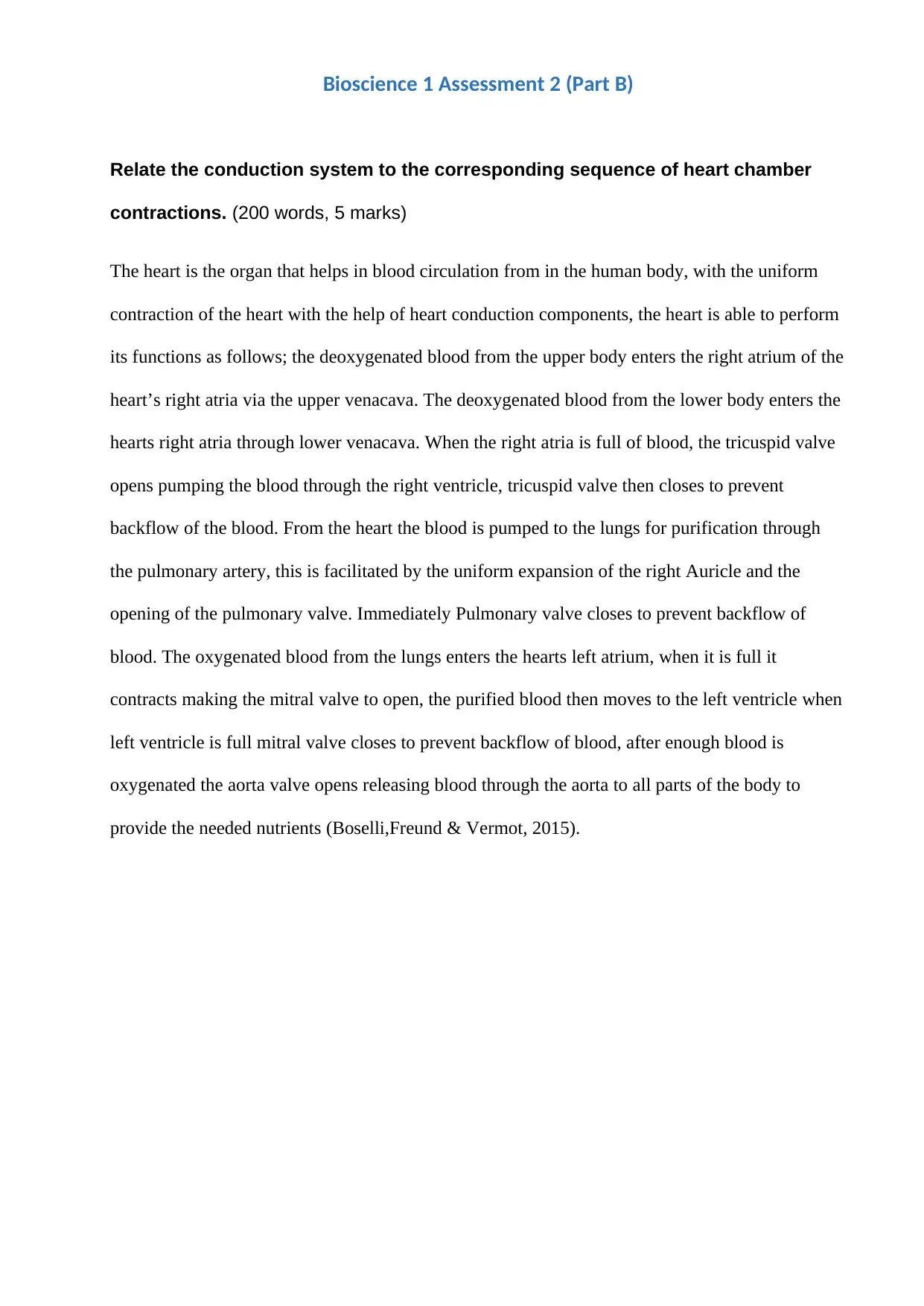
Bioscience 1 Assessment 2 (Part B)
Relate the conduction system to the corresponding sequence of heart chamber
contractions. (200 words, 5 marks)
The heart is the organ that helps in blood circulation from in the human body, with the uniform
contraction of the heart with the help of heart conduction components, the heart is able to perform
its functions as follows; the deoxygenated blood from the upper body enters the right atrium of the
heart’s right atria via the upper venacava. The deoxygenated blood from the lower body enters the
hearts right atria through lower venacava. When the right atria is full of blood, the tricuspid valve
opens pumping the blood through the right ventricle, tricuspid valve then closes to prevent
backflow of the blood. From the heart the blood is pumped to the lungs for purification through
the pulmonary artery, this is facilitated by the uniform expansion of the right Auricle and the
opening of the pulmonary valve. Immediately Pulmonary valve closes to prevent backflow of
blood. The oxygenated blood from the lungs enters the hearts left atrium, when it is full it
contracts making the mitral valve to open, the purified blood then moves to the left ventricle when
left ventricle is full mitral valve closes to prevent backflow of blood, after enough blood is
oxygenated the aorta valve opens releasing blood through the aorta to all parts of the body to
provide the needed nutrients (Boselli,Freund & Vermot, 2015).
Relate the conduction system to the corresponding sequence of heart chamber
contractions. (200 words, 5 marks)
The heart is the organ that helps in blood circulation from in the human body, with the uniform
contraction of the heart with the help of heart conduction components, the heart is able to perform
its functions as follows; the deoxygenated blood from the upper body enters the right atrium of the
heart’s right atria via the upper venacava. The deoxygenated blood from the lower body enters the
hearts right atria through lower venacava. When the right atria is full of blood, the tricuspid valve
opens pumping the blood through the right ventricle, tricuspid valve then closes to prevent
backflow of the blood. From the heart the blood is pumped to the lungs for purification through
the pulmonary artery, this is facilitated by the uniform expansion of the right Auricle and the
opening of the pulmonary valve. Immediately Pulmonary valve closes to prevent backflow of
blood. The oxygenated blood from the lungs enters the hearts left atrium, when it is full it
contracts making the mitral valve to open, the purified blood then moves to the left ventricle when
left ventricle is full mitral valve closes to prevent backflow of blood, after enough blood is
oxygenated the aorta valve opens releasing blood through the aorta to all parts of the body to
provide the needed nutrients (Boselli,Freund & Vermot, 2015).
Secure Best Marks with AI Grader
Need help grading? Try our AI Grader for instant feedback on your assignments.
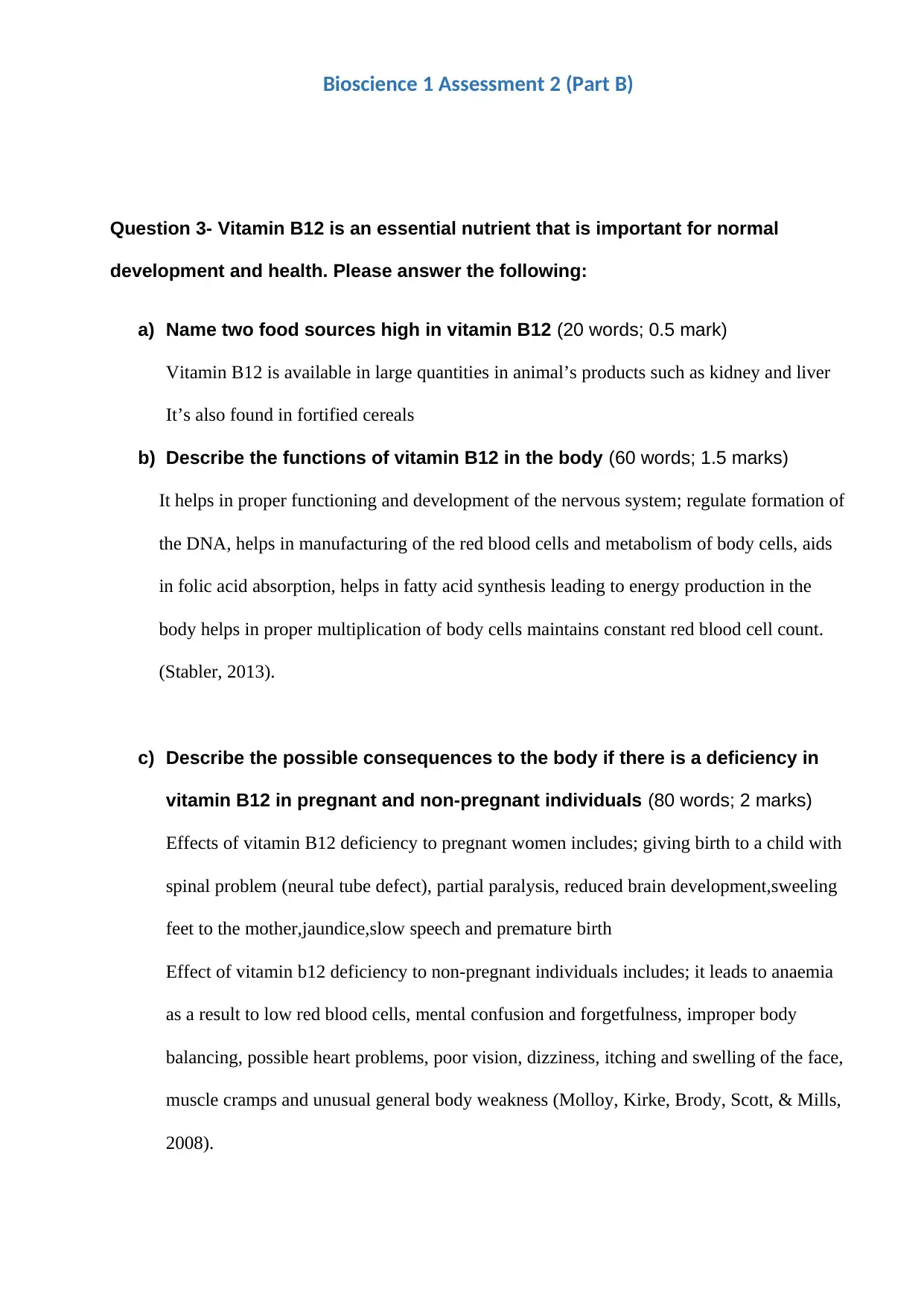
Bioscience 1 Assessment 2 (Part B)
Question 3- Vitamin B12 is an essential nutrient that is important for normal
development and health. Please answer the following:
a) Name two food sources high in vitamin B12 (20 words; 0.5 mark)
Vitamin B12 is available in large quantities in animal’s products such as kidney and liver
It’s also found in fortified cereals
b) Describe the functions of vitamin B12 in the body (60 words; 1.5 marks)
It helps in proper functioning and development of the nervous system; regulate formation of
the DNA, helps in manufacturing of the red blood cells and metabolism of body cells, aids
in folic acid absorption, helps in fatty acid synthesis leading to energy production in the
body helps in proper multiplication of body cells maintains constant red blood cell count.
(Stabler, 2013).
c) Describe the possible consequences to the body if there is a deficiency in
vitamin B12 in pregnant and non-pregnant individuals (80 words; 2 marks)
Effects of vitamin B12 deficiency to pregnant women includes; giving birth to a child with
spinal problem (neural tube defect), partial paralysis, reduced brain development,sweeling
feet to the mother,jaundice,slow speech and premature birth
Effect of vitamin b12 deficiency to non-pregnant individuals includes; it leads to anaemia
as a result to low red blood cells, mental confusion and forgetfulness, improper body
balancing, possible heart problems, poor vision, dizziness, itching and swelling of the face,
muscle cramps and unusual general body weakness (Molloy, Kirke, Brody, Scott, & Mills,
2008).
Question 3- Vitamin B12 is an essential nutrient that is important for normal
development and health. Please answer the following:
a) Name two food sources high in vitamin B12 (20 words; 0.5 mark)
Vitamin B12 is available in large quantities in animal’s products such as kidney and liver
It’s also found in fortified cereals
b) Describe the functions of vitamin B12 in the body (60 words; 1.5 marks)
It helps in proper functioning and development of the nervous system; regulate formation of
the DNA, helps in manufacturing of the red blood cells and metabolism of body cells, aids
in folic acid absorption, helps in fatty acid synthesis leading to energy production in the
body helps in proper multiplication of body cells maintains constant red blood cell count.
(Stabler, 2013).
c) Describe the possible consequences to the body if there is a deficiency in
vitamin B12 in pregnant and non-pregnant individuals (80 words; 2 marks)
Effects of vitamin B12 deficiency to pregnant women includes; giving birth to a child with
spinal problem (neural tube defect), partial paralysis, reduced brain development,sweeling
feet to the mother,jaundice,slow speech and premature birth
Effect of vitamin b12 deficiency to non-pregnant individuals includes; it leads to anaemia
as a result to low red blood cells, mental confusion and forgetfulness, improper body
balancing, possible heart problems, poor vision, dizziness, itching and swelling of the face,
muscle cramps and unusual general body weakness (Molloy, Kirke, Brody, Scott, & Mills,
2008).
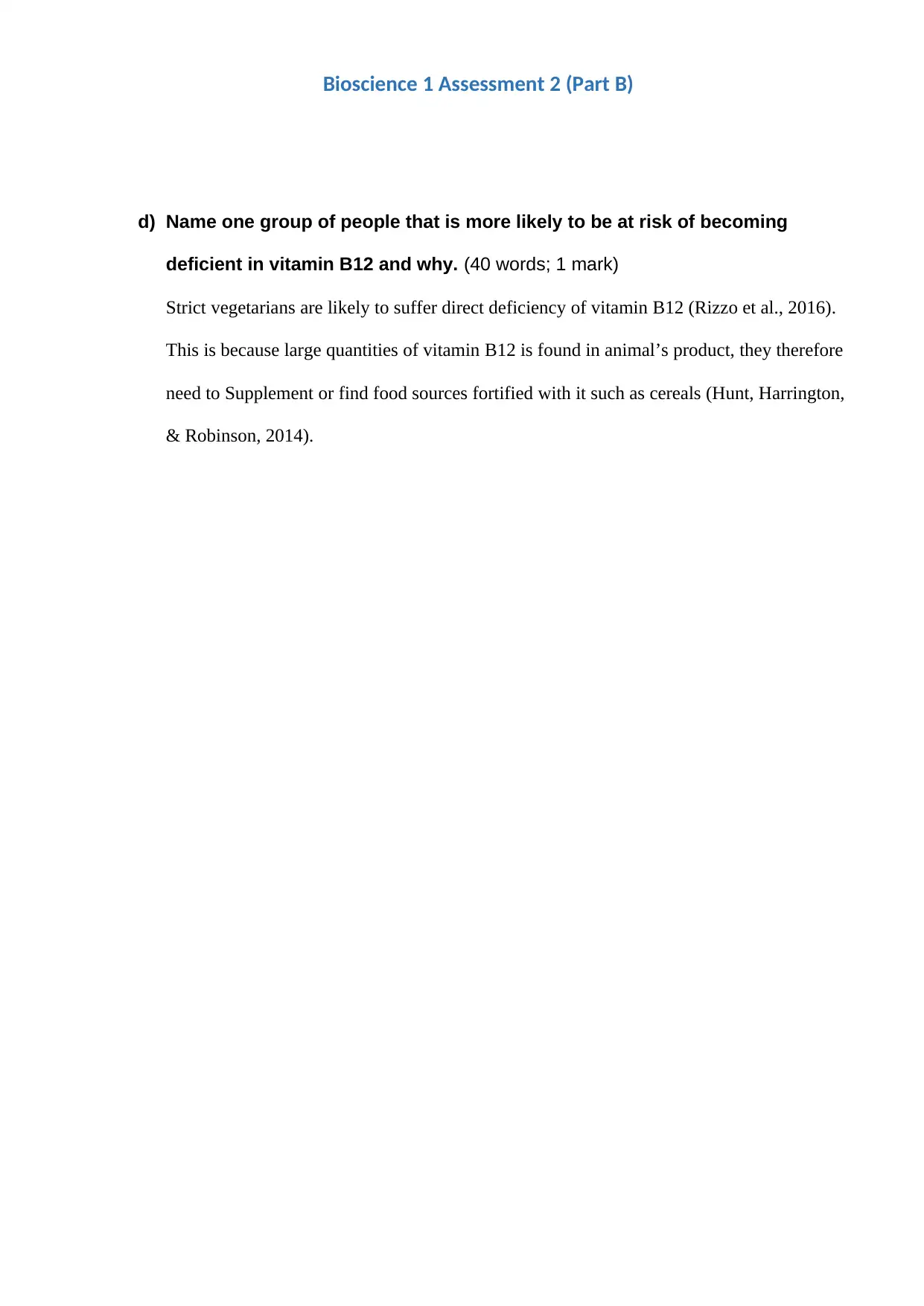
Bioscience 1 Assessment 2 (Part B)
d) Name one group of people that is more likely to be at risk of becoming
deficient in vitamin B12 and why. (40 words; 1 mark)
Strict vegetarians are likely to suffer direct deficiency of vitamin B12 (Rizzo et al., 2016).
This is because large quantities of vitamin B12 is found in animal’s product, they therefore
need to Supplement or find food sources fortified with it such as cereals (Hunt, Harrington,
& Robinson, 2014).
d) Name one group of people that is more likely to be at risk of becoming
deficient in vitamin B12 and why. (40 words; 1 mark)
Strict vegetarians are likely to suffer direct deficiency of vitamin B12 (Rizzo et al., 2016).
This is because large quantities of vitamin B12 is found in animal’s product, they therefore
need to Supplement or find food sources fortified with it such as cereals (Hunt, Harrington,
& Robinson, 2014).
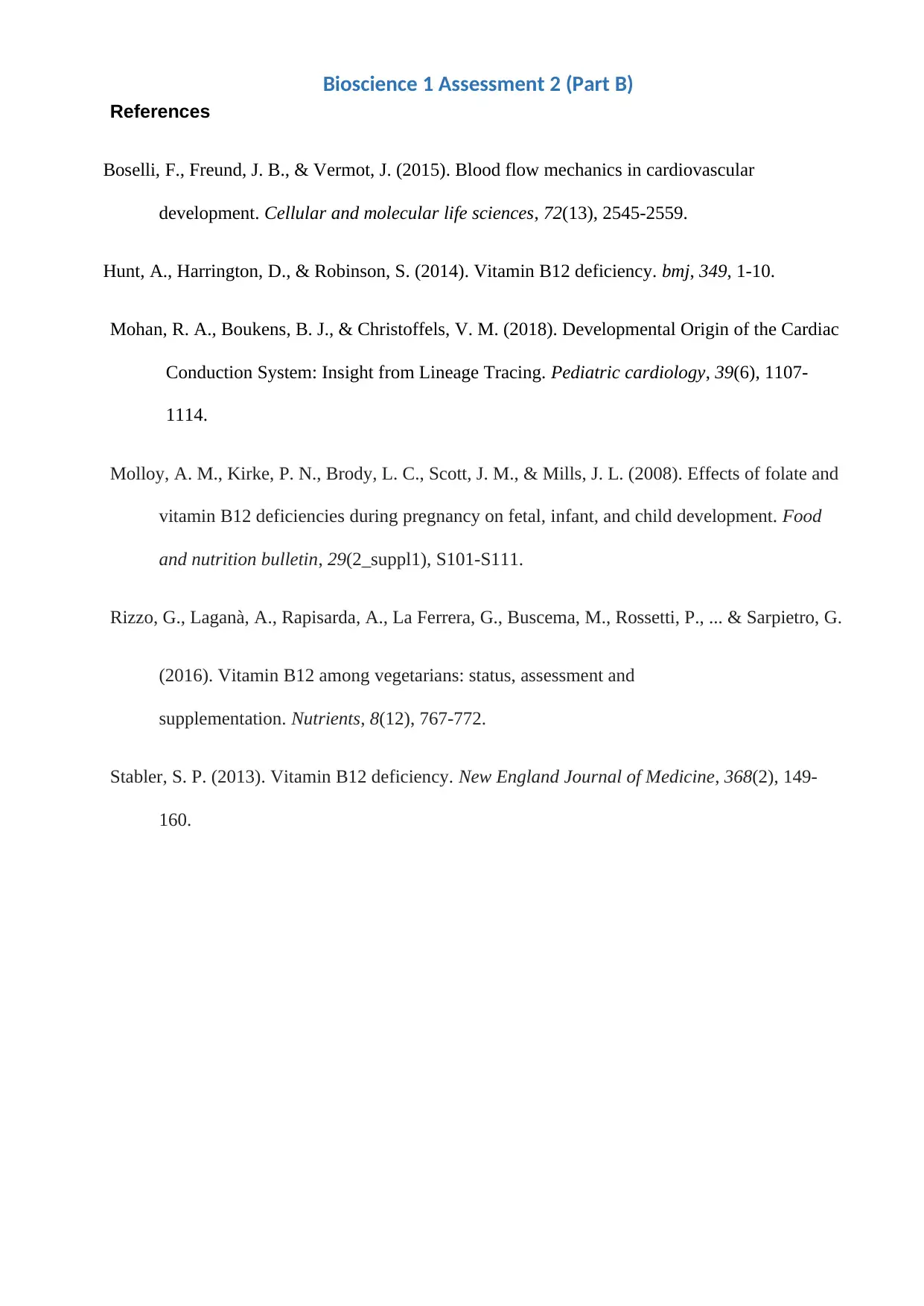
Bioscience 1 Assessment 2 (Part B)
References
Boselli, F., Freund, J. B., & Vermot, J. (2015). Blood flow mechanics in cardiovascular
development. Cellular and molecular life sciences, 72(13), 2545-2559.
Hunt, A., Harrington, D., & Robinson, S. (2014). Vitamin B12 deficiency. bmj, 349, 1-10.
Mohan, R. A., Boukens, B. J., & Christoffels, V. M. (2018). Developmental Origin of the Cardiac
Conduction System: Insight from Lineage Tracing. Pediatric cardiology, 39(6), 1107-
1114.
Molloy, A. M., Kirke, P. N., Brody, L. C., Scott, J. M., & Mills, J. L. (2008). Effects of folate and
vitamin B12 deficiencies during pregnancy on fetal, infant, and child development. Food
and nutrition bulletin, 29(2_suppl1), S101-S111.
Rizzo, G., Laganà, A., Rapisarda, A., La Ferrera, G., Buscema, M., Rossetti, P., ... & Sarpietro, G.
(2016). Vitamin B12 among vegetarians: status, assessment and
supplementation. Nutrients, 8(12), 767-772.
Stabler, S. P. (2013). Vitamin B12 deficiency. New England Journal of Medicine, 368(2), 149-
160.
References
Boselli, F., Freund, J. B., & Vermot, J. (2015). Blood flow mechanics in cardiovascular
development. Cellular and molecular life sciences, 72(13), 2545-2559.
Hunt, A., Harrington, D., & Robinson, S. (2014). Vitamin B12 deficiency. bmj, 349, 1-10.
Mohan, R. A., Boukens, B. J., & Christoffels, V. M. (2018). Developmental Origin of the Cardiac
Conduction System: Insight from Lineage Tracing. Pediatric cardiology, 39(6), 1107-
1114.
Molloy, A. M., Kirke, P. N., Brody, L. C., Scott, J. M., & Mills, J. L. (2008). Effects of folate and
vitamin B12 deficiencies during pregnancy on fetal, infant, and child development. Food
and nutrition bulletin, 29(2_suppl1), S101-S111.
Rizzo, G., Laganà, A., Rapisarda, A., La Ferrera, G., Buscema, M., Rossetti, P., ... & Sarpietro, G.
(2016). Vitamin B12 among vegetarians: status, assessment and
supplementation. Nutrients, 8(12), 767-772.
Stabler, S. P. (2013). Vitamin B12 deficiency. New England Journal of Medicine, 368(2), 149-
160.
1 out of 7
Related Documents
Your All-in-One AI-Powered Toolkit for Academic Success.
+13062052269
info@desklib.com
Available 24*7 on WhatsApp / Email
![[object Object]](/_next/static/media/star-bottom.7253800d.svg)
Unlock your academic potential
© 2024 | Zucol Services PVT LTD | All rights reserved.





